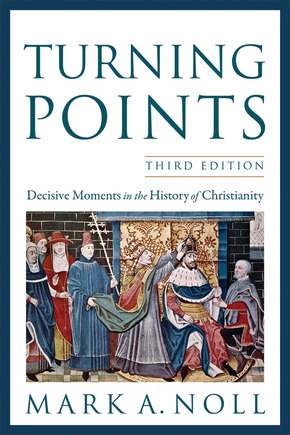Mark Noll: Turning Points
 Mark A. Noll, Turning Points: Decisive Moments in the History of Christianity, 3rd Edition (Grand Rapids: Baker, 2012), 356 pages.
Mark A. Noll, Turning Points: Decisive Moments in the History of Christianity, 3rd Edition (Grand Rapids: Baker, 2012), 356 pages.
Mark Noll is professor of history at the University of Notre Dame. He has taken up the challenge of constructing a “Church history” textbook for undergraduate college students in order to compress the most vital historical information into the confines of a typical college semester. In addition to a helpful introduction, he includes 13 chapters that unveil some of the essential milestones or turning points in Christian history, and an “afterward” where Noll briefly touches on events of the last century. Each chapter has between four and ten study guide questions, with additional questions of practical application for the church today. Additionally, each chapter concludes with a supplemental list of “further readings” to guide the student towards additional resources that will expand the ideas presented.
Even though the reviewer would have chosen a couple different events in history, he offers no criticism for the historical turning points Noll has presented. Chapter one explains how the Church moves from the pages of the Bible into the narratives of the early Church, the cannon of scripture, and the early creeds. Chapters two and three dig into the story of Constantine, the challenges of the councils of Nicaea and Chalcedon, elaborating on the nature of Christ and the political-ecclesiastical tensions of the Church. Chapter four explores the rise of monasticism, the Rule of St. Benedict, and the ways that these have served the development of the Church.
Stepping over a couple centuries, chapter five guides the student into the significance of Charlemagne’s coronation and the authority of the papacy. Then, stepping over two more centuries, chapter six unpacks the East-West tension, which will eventuate in the Great Schism between the Roman Catholic and Eastern Orthodox traditions of Christianity. Then, only a couple pages are given to the catastrophe of the crusades.
Another giant step in the timeline brings the student to the Reformation. Chapter seven finds Luther in the throes of defending his case against corruption and quickly touches on the main points of the reformers. Chapter eight elaborates the parallel controversies in England as Henry VIII seeks both an heir to succeed him and the headship of the Church of England. This chapter also adds a bit of background of the Anabaptist movement, which may make this era confusing for the college student, because too much new information is introduced at one time, without fully delineating it. Chapter nine describes the Catholic Reformation and the role of Ignatius Loyola and the Jesuits.
Chapter ten strides over a couple more centuries and begins with the story of the Wesley brothers, then elaborates on evangelicalism and pietism. Chapter eleven quickly marches through the French Revolution, the rise of Modernity, and then the reactions of the Church towards these. Chapter twelve describes the expansion of the Missions Movement as it reaches into Asia and Africa. The thirteenth chapter draws attention to the Second Vatican Council and the Lausanne Congress on World Evangelism. And then, the afterword briefly mentions the Pentecostal Movement, the rise of women in ministry, the work of Bible translation, and the survival of the Church under communism.
Any teacher who has labored to teach 2000 years of history in a 3 credit course has walked away knowing that too much has been left undone and unsaid. There will always be gaps in chronology and whole topics left unexplored. In this book, Noll gives us his attempt to pare down the whole story into what he deems to be the most important events in Church history, in order to give his students some benchmarks to measure the whole. These benchmarks will provide a conceptual framework for further information to be added in the never-ending study of history. I have walked away from this book with some ideas of how I will modify my own Church history courses in the upcoming semesters.
Reviewed by John Miller
Preview the third edition of Turning Points: https://books.google.com/books?id=7rJvhpg0S9sC
Publisher’s page: http://bakerpublishinggroup.com/books/turning-points-3rd-edition/223385
Category: Church History, Summer 2016


